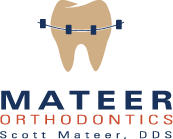If you’ve recently learned that your smile could benefit from braces, you probably have a whole laundry list of questions, everything from whether or not they’ll hurt to what kind of foods you should avoid. Here at Mateer Orthodontics, one of the first questions we hear from patients is often “…but how long will I have to wear them?” While there’s no easy answer, we can take a look at some of the factors that can impact treatment time, as well as the average estimated treatment times for braces. We’ll even discuss things you can do to possibly speed up your time spent in treatment! Let’s start with….
Factors that affect treatment time
Each patient is treated according to their own unique orthodontic issues, so there are several factors we have to take into consideration when looking at an estimated orthodontic treatment time. These can range from the age of the patient, to their adherence to recommendations, to the severity of their case. Because we can’t predict exactly how a patient will respond to treatment, the treatment times will vary from person to person.
Even though there’s no answer set in stone when it comes to the total time you’ll be in braces, taking all factors into consideration, braces tend to be worn for anywhere from roughly one to three years on average, for comprehensive treatment.
Wondering which factors play a part in determining treatment times? The single biggest factor in determining the length of time you’ll need to be in braces is the severity of your specific case. We also look at things like
- the amount of room available in your mouth
- the distance the teeth will have to travel to meet their goal
- the health of your teeth, gums, and supporting bone
- how closely you follow instructions
The American Association of Orthodontists recommends all children see an orthodontist by around the age of 7, and we agree. One of the biggest reasons why is because many potential problems can be caught early this way. Research has shown that the earlier someone gets braces, the faster their treatment will usually be. Generally speaking, the most optimal time for getting braces is around 11-14 years old. As long as dental development is normal, and barring any serious oral issues, treatment time can often be fairly quick at this age. Don’t worry if you’ve bypassed this window, though – even adult treatment can be more successful if you practice excellent oral hygiene!
For younger patients, it’s especially important to stress good dental hygiene, and the valuable role it plays in orthodontic treatment. Although traditional metal braces can make thorough brushing and flossing a little tricky, there are several products designed to make it easier, such as interdental toothbrushes and Waterpiks. By brushing and flossing at least twice a day, and strictly following instructions about caring for their teeth, our tween and teen patients can sometimes even cut time off how long they’ll need to wear braces.
Body response plays a part in treatment times, too. For some patients, the teeth move faster than normal, while for others, they move more slowly than we anticipate. These are factors that neither you nor your orthodontist can control. Even if you’re both vigilant about your braces treatment, we still need your teeth and jaws to cooperate in order for you to complete it in the time estimated.
Because there are so many different components to orthodontics, estimated treatment times can change at any point in the process. For example, damaged braces may have to be worn a bit longer as they’ll require repairs to be made. There are times where a patient’s teeth just aren’t cooperating with the process for some reason, and the orthodontist will have to make some adjustments and come up with a new estimate for when the braces are likely to come off. On the plus side, though, there may be times when teeth move faster than anticipated, and the braces can come off sooner than expected!
The part you play in treatment time
There is one way you can maintain some control over your treatment plan and how long your braces remain on, and that’s by always following the instructions you receive from your orthodontist! Getting the perfect diagnosis and treatment plan won’t mean much without your cooperation.
Paying special attention to your dental hygiene is a great way to work with your orthodontist to keep your treatment sailing along. But what else can you do to help ensure you complete your treatment within the estimated time?
To avoid any potential complications, it’s important to keep all your appointments and to visit your orthodontist as directed. To keep your treatment plan on schedule, you should try to always
- stick to all your scheduled appointment dates
- when you can’t, reschedule appointments as close to your original appointment date as possible
- arrive on time for your appointments
- take care of any required procedures in a timely manner to prevent complications
- follow your orthodontist’s guidelines on dental hygiene
It’s easier than you think to sabotage your own treatment! Doing any of the following things could result in more time in braces:
- missing, changing, or spreading your appointments out too far
- regularly arriving late to appointments
- putting off necessary procedures like surgeries, extractions, etc.
- frequently breaking or bending your wires or brackets between visits
- not practicing good oral hygiene
Diet is also an important, but often neglected, aspect of your oral health. When wearing braces, there are certain foods you should steer clear of because of the damage they can cause to your braces or teeth. This includes:
- anything hard, like popcorn, certain candy, raw apples or carrots
- anything sticky or chewy, such as caramel, tough cuts of meat, or gummy bears
You should also avoid acidic items (sodas, lemons, or oranges) and sugary foods and drinks (sweets, sodas, smoothies, and overly processed foods) because they can affect the enamel and bacteria levels in your teeth and mouth.
A little patience goes a long way
It’s important to remind yourself throughout the course of your treatment that no two smiles are the same. Understanding that not everyone will respond to orthodontic treatment in the same way will give you some much-needed perspective that will help keep you patiently waiting for the big day your braces come off!
The total treatment experience with Mateer Orthodontics
Here at Mateer Orthodontics, we take pride in providing an honest, caring approach to orthodontic treatment for all our patients. You’re not just another number to us! We believe that long-term treatment builds a meaningful relationship between our office and our patients, and that that can translate to a lifetime of better oral health.
If you’re in the Commack or surrounding areas, and want more information on how braces can have a positive impact on your life and your smile, get in touch with us today. We’re here to get you started on the road to a straighter smile!




